Mathematics, Science and Technology in EYLF
VerifiedAdded on 2023/06/04
|15
|4324
|247
AI Summary
This article explores how children aged between zero and four years can learn about technology, mathematics and science through play and exploration. It discusses the importance of educators in guiding children in developing their understanding of these concepts. The article also provides a learning experience plan and evaluation of teaching and learning.
Contribute Materials
Your contribution can guide someone’s learning journey. Share your
documents today.
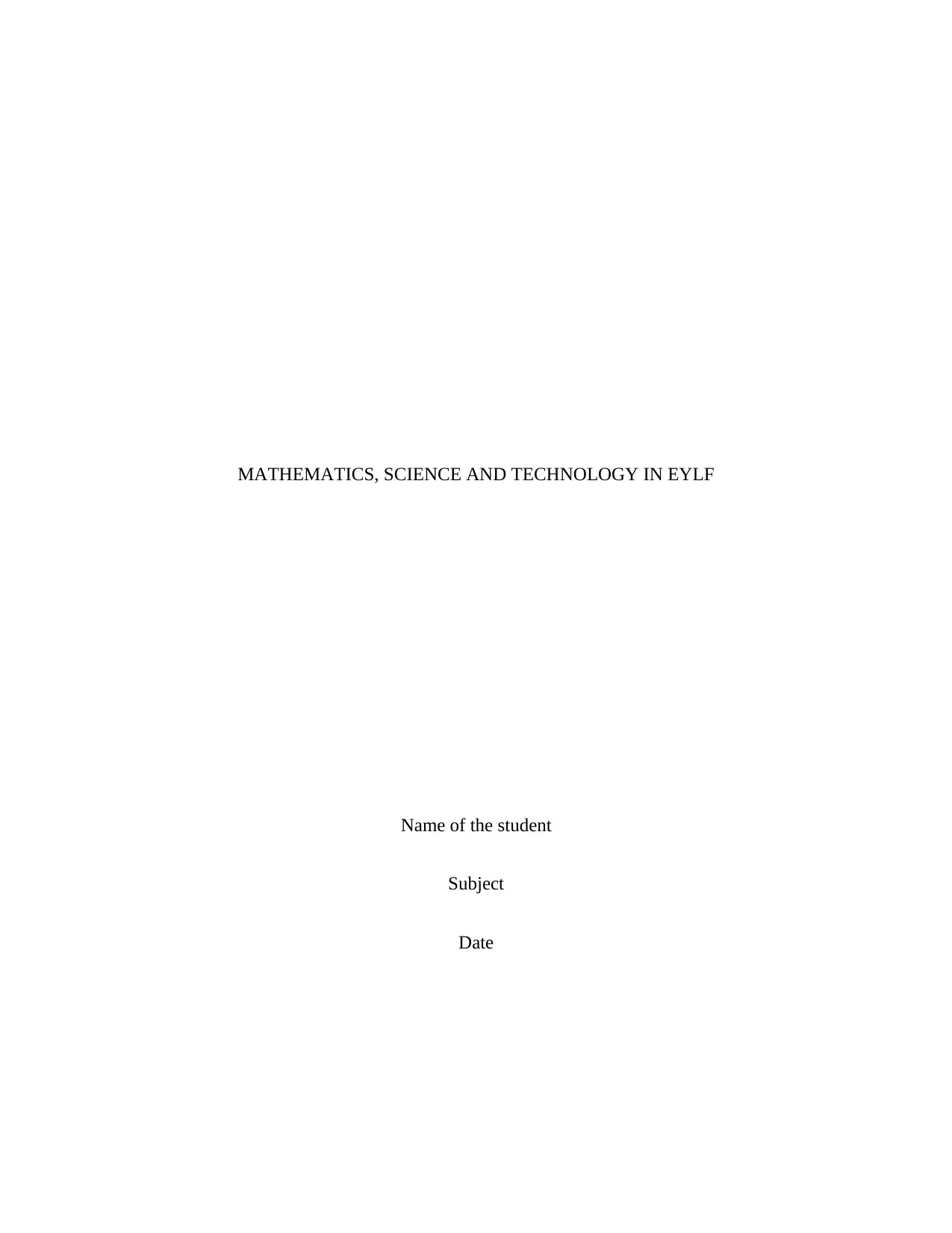
MATHEMATICS, SCIENCE AND TECHNOLOGY IN EYLF
Name of the student
Subject
Date
Name of the student
Subject
Date
Secure Best Marks with AI Grader
Need help grading? Try our AI Grader for instant feedback on your assignments.
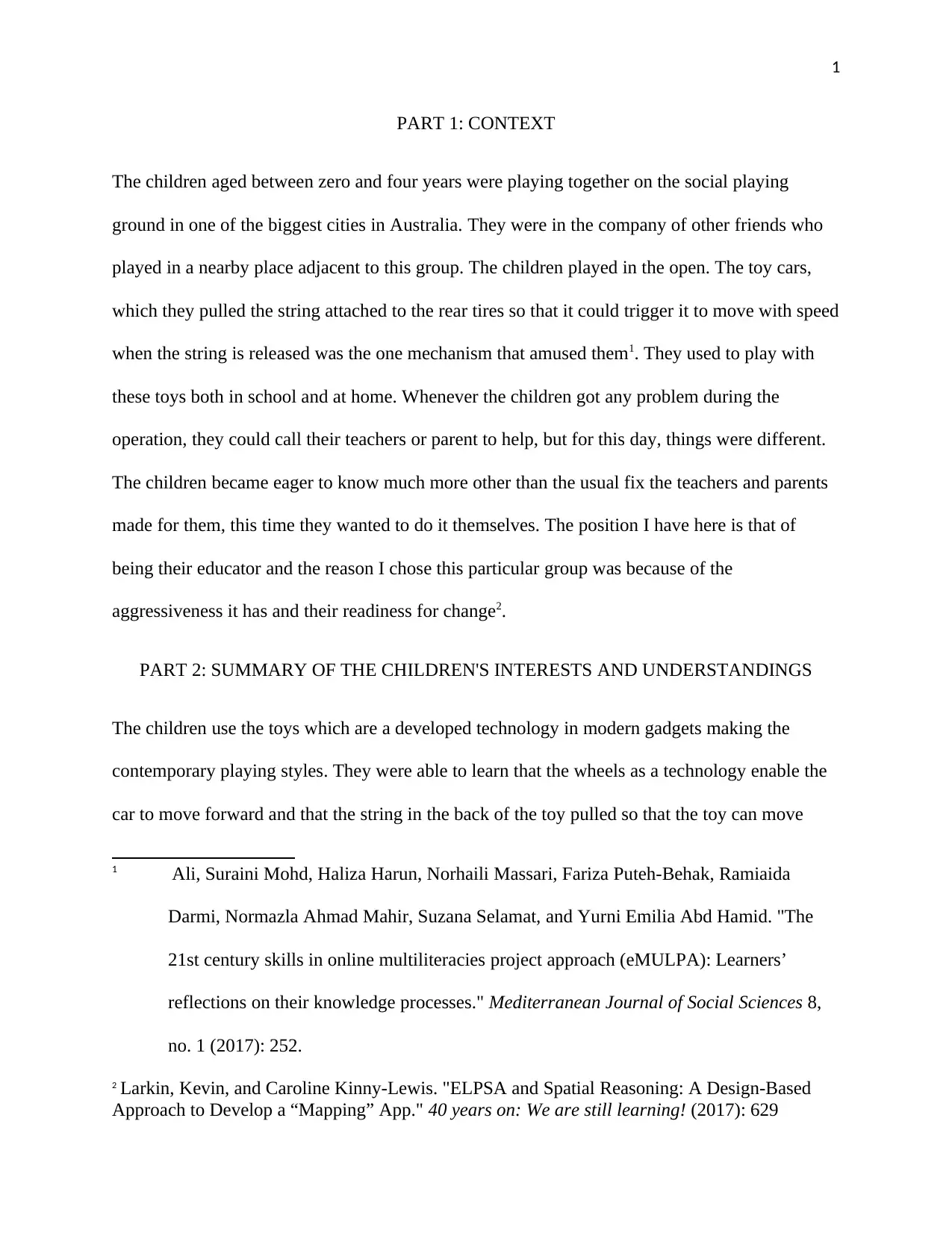
1
PART 1: CONTEXT
The children aged between zero and four years were playing together on the social playing
ground in one of the biggest cities in Australia. They were in the company of other friends who
played in a nearby place adjacent to this group. The children played in the open. The toy cars,
which they pulled the string attached to the rear tires so that it could trigger it to move with speed
when the string is released was the one mechanism that amused them1. They used to play with
these toys both in school and at home. Whenever the children got any problem during the
operation, they could call their teachers or parent to help, but for this day, things were different.
The children became eager to know much more other than the usual fix the teachers and parents
made for them, this time they wanted to do it themselves. The position I have here is that of
being their educator and the reason I chose this particular group was because of the
aggressiveness it has and their readiness for change2.
PART 2: SUMMARY OF THE CHILDREN'S INTERESTS AND UNDERSTANDINGS
The children use the toys which are a developed technology in modern gadgets making the
contemporary playing styles. They were able to learn that the wheels as a technology enable the
car to move forward and that the string in the back of the toy pulled so that the toy can move
1 Ali, Suraini Mohd, Haliza Harun, Norhaili Massari, Fariza Puteh-Behak, Ramiaida
Darmi, Normazla Ahmad Mahir, Suzana Selamat, and Yurni Emilia Abd Hamid. "The
21st century skills in online multiliteracies project approach (eMULPA): Learners’
reflections on their knowledge processes." Mediterranean Journal of Social Sciences 8,
no. 1 (2017): 252.
2 Larkin, Kevin, and Caroline Kinny-Lewis. "ELPSA and Spatial Reasoning: A Design-Based
Approach to Develop a “Mapping” App." 40 years on: We are still learning! (2017): 629
PART 1: CONTEXT
The children aged between zero and four years were playing together on the social playing
ground in one of the biggest cities in Australia. They were in the company of other friends who
played in a nearby place adjacent to this group. The children played in the open. The toy cars,
which they pulled the string attached to the rear tires so that it could trigger it to move with speed
when the string is released was the one mechanism that amused them1. They used to play with
these toys both in school and at home. Whenever the children got any problem during the
operation, they could call their teachers or parent to help, but for this day, things were different.
The children became eager to know much more other than the usual fix the teachers and parents
made for them, this time they wanted to do it themselves. The position I have here is that of
being their educator and the reason I chose this particular group was because of the
aggressiveness it has and their readiness for change2.
PART 2: SUMMARY OF THE CHILDREN'S INTERESTS AND UNDERSTANDINGS
The children use the toys which are a developed technology in modern gadgets making the
contemporary playing styles. They were able to learn that the wheels as a technology enable the
car to move forward and that the string in the back of the toy pulled so that the toy can move
1 Ali, Suraini Mohd, Haliza Harun, Norhaili Massari, Fariza Puteh-Behak, Ramiaida
Darmi, Normazla Ahmad Mahir, Suzana Selamat, and Yurni Emilia Abd Hamid. "The
21st century skills in online multiliteracies project approach (eMULPA): Learners’
reflections on their knowledge processes." Mediterranean Journal of Social Sciences 8,
no. 1 (2017): 252.
2 Larkin, Kevin, and Caroline Kinny-Lewis. "ELPSA and Spatial Reasoning: A Design-Based
Approach to Develop a “Mapping” App." 40 years on: We are still learning! (2017): 629
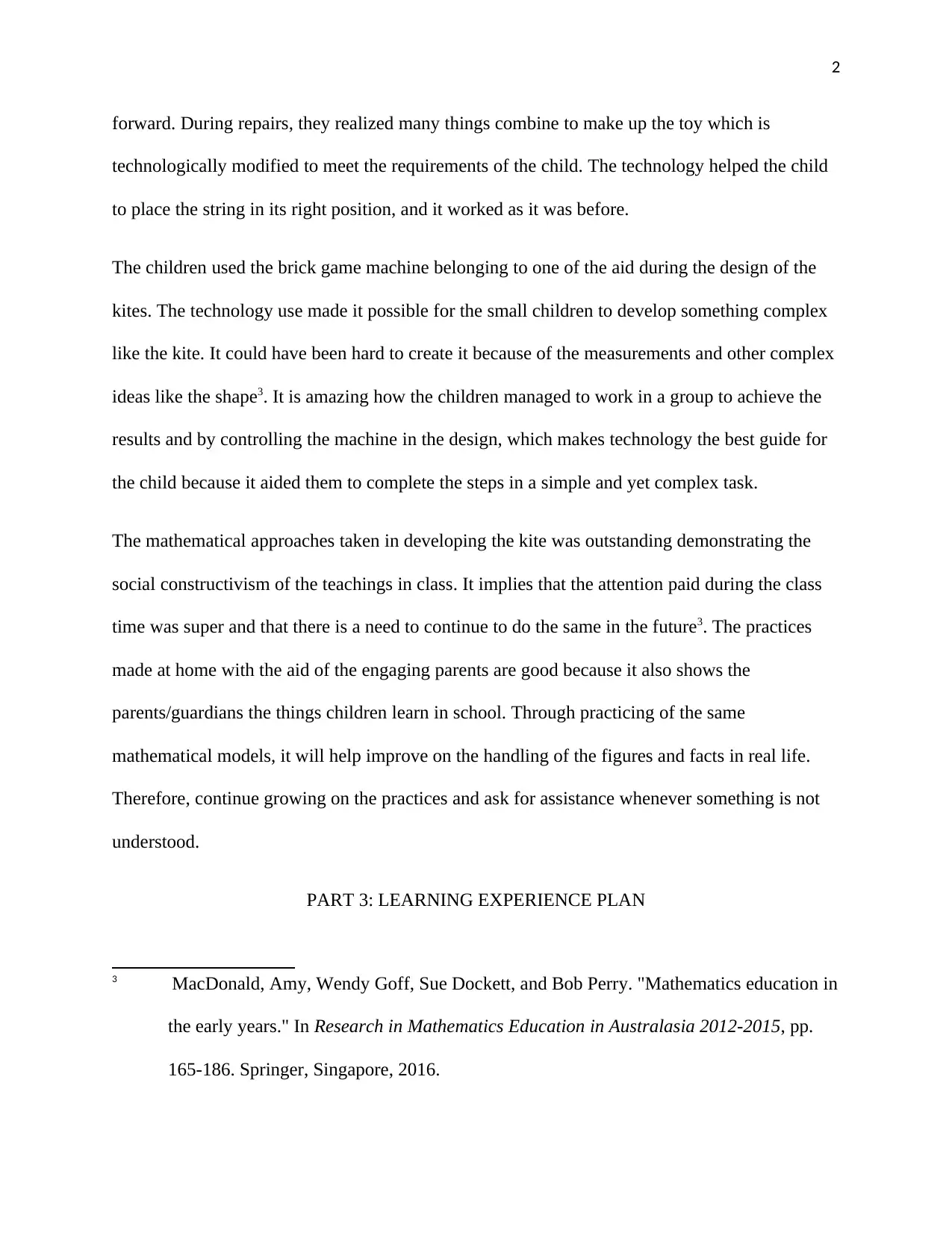
2
forward. During repairs, they realized many things combine to make up the toy which is
technologically modified to meet the requirements of the child. The technology helped the child
to place the string in its right position, and it worked as it was before.
The children used the brick game machine belonging to one of the aid during the design of the
kites. The technology use made it possible for the small children to develop something complex
like the kite. It could have been hard to create it because of the measurements and other complex
ideas like the shape3. It is amazing how the children managed to work in a group to achieve the
results and by controlling the machine in the design, which makes technology the best guide for
the child because it aided them to complete the steps in a simple and yet complex task.
The mathematical approaches taken in developing the kite was outstanding demonstrating the
social constructivism of the teachings in class. It implies that the attention paid during the class
time was super and that there is a need to continue to do the same in the future3. The practices
made at home with the aid of the engaging parents are good because it also shows the
parents/guardians the things children learn in school. Through practicing of the same
mathematical models, it will help improve on the handling of the figures and facts in real life.
Therefore, continue growing on the practices and ask for assistance whenever something is not
understood.
PART 3: LEARNING EXPERIENCE PLAN
3 MacDonald, Amy, Wendy Goff, Sue Dockett, and Bob Perry. "Mathematics education in
the early years." In Research in Mathematics Education in Australasia 2012-2015, pp.
165-186. Springer, Singapore, 2016.
forward. During repairs, they realized many things combine to make up the toy which is
technologically modified to meet the requirements of the child. The technology helped the child
to place the string in its right position, and it worked as it was before.
The children used the brick game machine belonging to one of the aid during the design of the
kites. The technology use made it possible for the small children to develop something complex
like the kite. It could have been hard to create it because of the measurements and other complex
ideas like the shape3. It is amazing how the children managed to work in a group to achieve the
results and by controlling the machine in the design, which makes technology the best guide for
the child because it aided them to complete the steps in a simple and yet complex task.
The mathematical approaches taken in developing the kite was outstanding demonstrating the
social constructivism of the teachings in class. It implies that the attention paid during the class
time was super and that there is a need to continue to do the same in the future3. The practices
made at home with the aid of the engaging parents are good because it also shows the
parents/guardians the things children learn in school. Through practicing of the same
mathematical models, it will help improve on the handling of the figures and facts in real life.
Therefore, continue growing on the practices and ask for assistance whenever something is not
understood.
PART 3: LEARNING EXPERIENCE PLAN
3 MacDonald, Amy, Wendy Goff, Sue Dockett, and Bob Perry. "Mathematics education in
the early years." In Research in Mathematics Education in Australasia 2012-2015, pp.
165-186. Springer, Singapore, 2016.
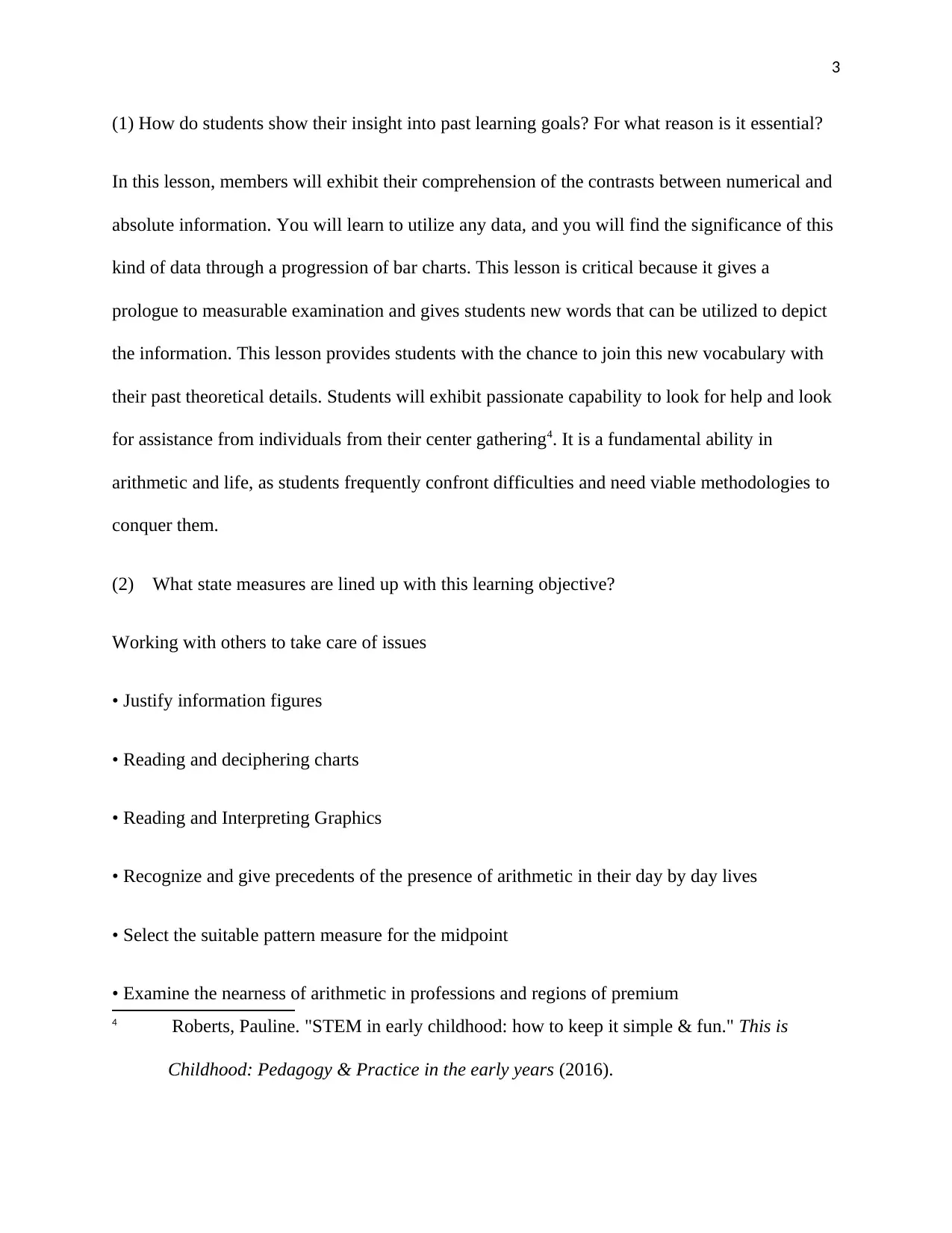
3
(1) How do students show their insight into past learning goals? For what reason is it essential?
In this lesson, members will exhibit their comprehension of the contrasts between numerical and
absolute information. You will learn to utilize any data, and you will find the significance of this
kind of data through a progression of bar charts. This lesson is critical because it gives a
prologue to measurable examination and gives students new words that can be utilized to depict
the information. This lesson provides students with the chance to join this new vocabulary with
their past theoretical details. Students will exhibit passionate capability to look for help and look
for assistance from individuals from their center gathering4. It is a fundamental ability in
arithmetic and life, as students frequently confront difficulties and need viable methodologies to
conquer them.
(2) What state measures are lined up with this learning objective?
Working with others to take care of issues
• Justify information figures
• Reading and deciphering charts
• Reading and Interpreting Graphics
• Recognize and give precedents of the presence of arithmetic in their day by day lives
• Select the suitable pattern measure for the midpoint
• Examine the nearness of arithmetic in professions and regions of premium
4 Roberts, Pauline. "STEM in early childhood: how to keep it simple & fun." This is
Childhood: Pedagogy & Practice in the early years (2016).
(1) How do students show their insight into past learning goals? For what reason is it essential?
In this lesson, members will exhibit their comprehension of the contrasts between numerical and
absolute information. You will learn to utilize any data, and you will find the significance of this
kind of data through a progression of bar charts. This lesson is critical because it gives a
prologue to measurable examination and gives students new words that can be utilized to depict
the information. This lesson provides students with the chance to join this new vocabulary with
their past theoretical details. Students will exhibit passionate capability to look for help and look
for assistance from individuals from their center gathering4. It is a fundamental ability in
arithmetic and life, as students frequently confront difficulties and need viable methodologies to
conquer them.
(2) What state measures are lined up with this learning objective?
Working with others to take care of issues
• Justify information figures
• Reading and deciphering charts
• Reading and Interpreting Graphics
• Recognize and give precedents of the presence of arithmetic in their day by day lives
• Select the suitable pattern measure for the midpoint
• Examine the nearness of arithmetic in professions and regions of premium
4 Roberts, Pauline. "STEM in early childhood: how to keep it simple & fun." This is
Childhood: Pedagogy & Practice in the early years (2016).
Secure Best Marks with AI Grader
Need help grading? Try our AI Grader for instant feedback on your assignments.

4
• Calculate the interim of a given record
• Filtering stage:
• Answers inquiries to edify others
(3) What does it entail for the learning experience to begin in the proper manner that includes
connections to early information and all students get involved?
To start this learning, students will get a progression of 10 individual questions experience, for
example, "What is your most loved sort of subject?" I "what number of subjects do you have?"
Based on past students' genuine experiences, students will answer these inquiries and after that
examine in class how they can utilize the questions to gather information about others. Students
rate each inquiry as per the kind of data separated from these answers5. It will mark clear-cut data
word information with a C and numerical information numeric information with an N. This
movement is intended to track the comprehension of information composes by current students.
Have students depend on dialogs about learning and experience.
(4) How will you ensure that all students will be ready to accomplish this learning objective?
(a) Use earlier information
(b) Advance positive associations with every student amid preparing?
(c) Interest in this lesson
5 Larkin, Kevin, and Caroline Kinny-Lewis. "ELPSA and Spatial Reasoning: A Design-
Based Approach to Develop a “Mapping” App." 40 years on: We are still learning!
(2017): 629.
• Calculate the interim of a given record
• Filtering stage:
• Answers inquiries to edify others
(3) What does it entail for the learning experience to begin in the proper manner that includes
connections to early information and all students get involved?
To start this learning, students will get a progression of 10 individual questions experience, for
example, "What is your most loved sort of subject?" I "what number of subjects do you have?"
Based on past students' genuine experiences, students will answer these inquiries and after that
examine in class how they can utilize the questions to gather information about others. Students
rate each inquiry as per the kind of data separated from these answers5. It will mark clear-cut data
word information with a C and numerical information numeric information with an N. This
movement is intended to track the comprehension of information composes by current students.
Have students depend on dialogs about learning and experience.
(4) How will you ensure that all students will be ready to accomplish this learning objective?
(a) Use earlier information
(b) Advance positive associations with every student amid preparing?
(c) Interest in this lesson
5 Larkin, Kevin, and Caroline Kinny-Lewis. "ELPSA and Spatial Reasoning: A Design-
Based Approach to Develop a “Mapping” App." 40 years on: We are still learning!
(2017): 629.
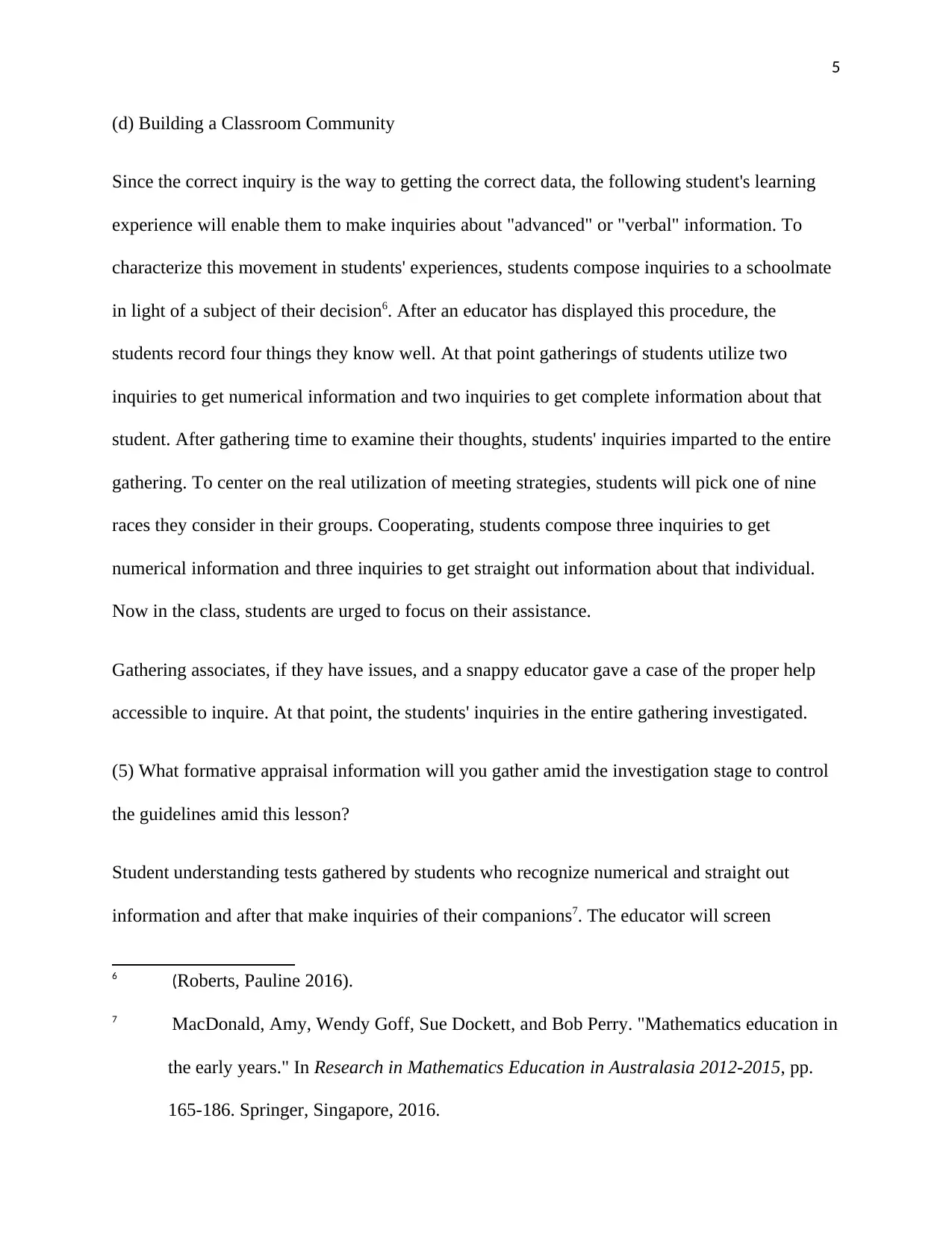
5
(d) Building a Classroom Community
Since the correct inquiry is the way to getting the correct data, the following student's learning
experience will enable them to make inquiries about "advanced" or "verbal" information. To
characterize this movement in students' experiences, students compose inquiries to a schoolmate
in light of a subject of their decision6. After an educator has displayed this procedure, the
students record four things they know well. At that point gatherings of students utilize two
inquiries to get numerical information and two inquiries to get complete information about that
student. After gathering time to examine their thoughts, students' inquiries imparted to the entire
gathering. To center on the real utilization of meeting strategies, students will pick one of nine
races they consider in their groups. Cooperating, students compose three inquiries to get
numerical information and three inquiries to get straight out information about that individual.
Now in the class, students are urged to focus on their assistance.
Gathering associates, if they have issues, and a snappy educator gave a case of the proper help
accessible to inquire. At that point, the students' inquiries in the entire gathering investigated.
(5) What formative appraisal information will you gather amid the investigation stage to control
the guidelines amid this lesson?
Student understanding tests gathered by students who recognize numerical and straight out
information and after that make inquiries of their companions7. The educator will screen
6 (Roberts, Pauline 2016).
7 MacDonald, Amy, Wendy Goff, Sue Dockett, and Bob Perry. "Mathematics education in
the early years." In Research in Mathematics Education in Australasia 2012-2015, pp.
165-186. Springer, Singapore, 2016.
(d) Building a Classroom Community
Since the correct inquiry is the way to getting the correct data, the following student's learning
experience will enable them to make inquiries about "advanced" or "verbal" information. To
characterize this movement in students' experiences, students compose inquiries to a schoolmate
in light of a subject of their decision6. After an educator has displayed this procedure, the
students record four things they know well. At that point gatherings of students utilize two
inquiries to get numerical information and two inquiries to get complete information about that
student. After gathering time to examine their thoughts, students' inquiries imparted to the entire
gathering. To center on the real utilization of meeting strategies, students will pick one of nine
races they consider in their groups. Cooperating, students compose three inquiries to get
numerical information and three inquiries to get straight out information about that individual.
Now in the class, students are urged to focus on their assistance.
Gathering associates, if they have issues, and a snappy educator gave a case of the proper help
accessible to inquire. At that point, the students' inquiries in the entire gathering investigated.
(5) What formative appraisal information will you gather amid the investigation stage to control
the guidelines amid this lesson?
Student understanding tests gathered by students who recognize numerical and straight out
information and after that make inquiries of their companions7. The educator will screen
6 (Roberts, Pauline 2016).
7 MacDonald, Amy, Wendy Goff, Sue Dockett, and Bob Perry. "Mathematics education in
the early years." In Research in Mathematics Education in Australasia 2012-2015, pp.
165-186. Springer, Singapore, 2016.
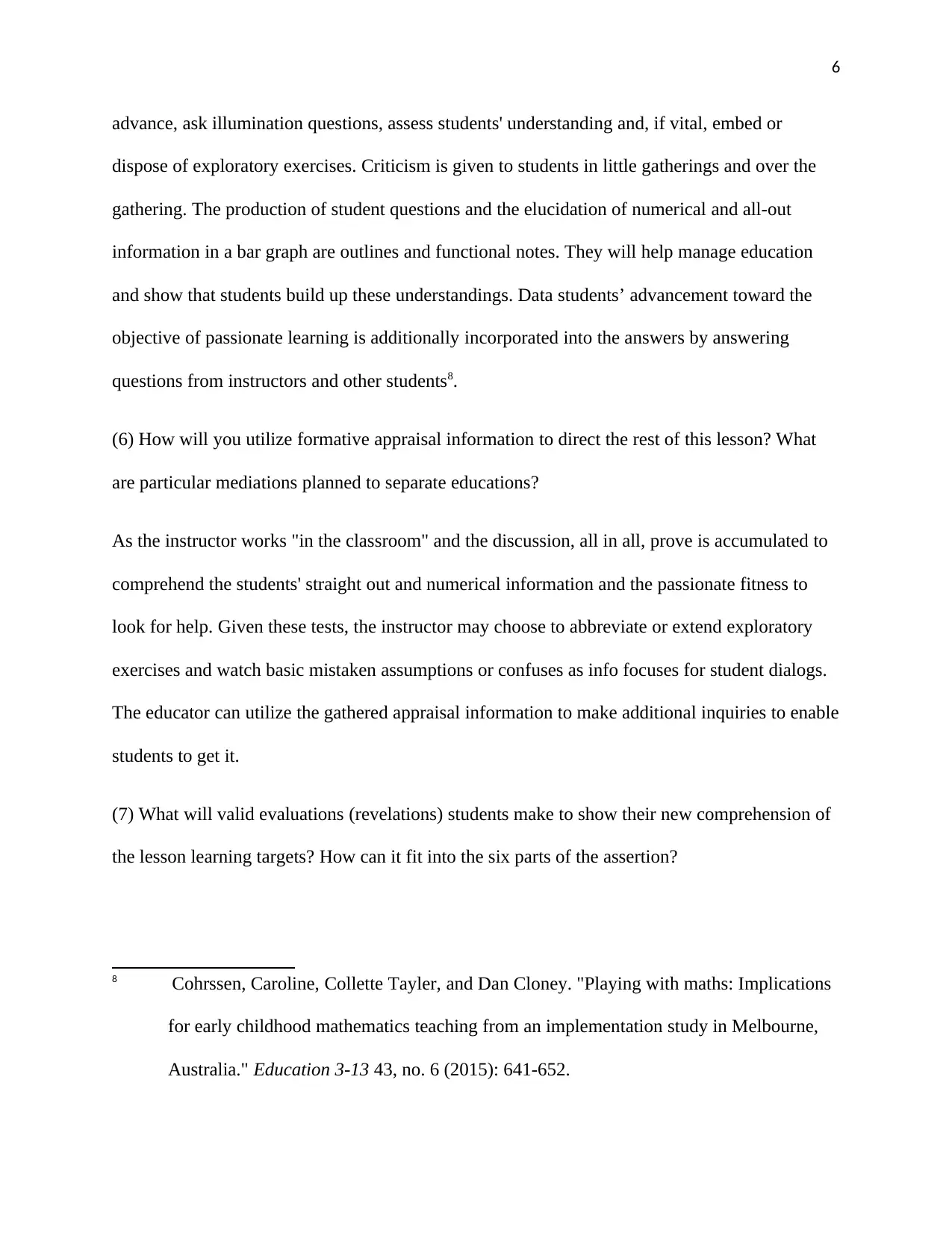
6
advance, ask illumination questions, assess students' understanding and, if vital, embed or
dispose of exploratory exercises. Criticism is given to students in little gatherings and over the
gathering. The production of student questions and the elucidation of numerical and all-out
information in a bar graph are outlines and functional notes. They will help manage education
and show that students build up these understandings. Data students’ advancement toward the
objective of passionate learning is additionally incorporated into the answers by answering
questions from instructors and other students8.
(6) How will you utilize formative appraisal information to direct the rest of this lesson? What
are particular mediations planned to separate educations?
As the instructor works "in the classroom" and the discussion, all in all, prove is accumulated to
comprehend the students' straight out and numerical information and the passionate fitness to
look for help. Given these tests, the instructor may choose to abbreviate or extend exploratory
exercises and watch basic mistaken assumptions or confuses as info focuses for student dialogs.
The educator can utilize the gathered appraisal information to make additional inquiries to enable
students to get it.
(7) What will valid evaluations (revelations) students make to show their new comprehension of
the lesson learning targets? How can it fit into the six parts of the assertion?
8 Cohrssen, Caroline, Collette Tayler, and Dan Cloney. "Playing with maths: Implications
for early childhood mathematics teaching from an implementation study in Melbourne,
Australia." Education 3-13 43, no. 6 (2015): 641-652.
advance, ask illumination questions, assess students' understanding and, if vital, embed or
dispose of exploratory exercises. Criticism is given to students in little gatherings and over the
gathering. The production of student questions and the elucidation of numerical and all-out
information in a bar graph are outlines and functional notes. They will help manage education
and show that students build up these understandings. Data students’ advancement toward the
objective of passionate learning is additionally incorporated into the answers by answering
questions from instructors and other students8.
(6) How will you utilize formative appraisal information to direct the rest of this lesson? What
are particular mediations planned to separate educations?
As the instructor works "in the classroom" and the discussion, all in all, prove is accumulated to
comprehend the students' straight out and numerical information and the passionate fitness to
look for help. Given these tests, the instructor may choose to abbreviate or extend exploratory
exercises and watch basic mistaken assumptions or confuses as info focuses for student dialogs.
The educator can utilize the gathered appraisal information to make additional inquiries to enable
students to get it.
(7) What will valid evaluations (revelations) students make to show their new comprehension of
the lesson learning targets? How can it fit into the six parts of the assertion?
8 Cohrssen, Caroline, Collette Tayler, and Dan Cloney. "Playing with maths: Implications
for early childhood mathematics teaching from an implementation study in Melbourne,
Australia." Education 3-13 43, no. 6 (2015): 641-652.
Paraphrase This Document
Need a fresh take? Get an instant paraphrase of this document with our AI Paraphraser

7
To apply, grow and relate the information created in the complete and numerical information of
students to the information conveyances considered in this unit, the student groups must translate
the data in a progression of graph and bars9. Each bar outline depicts the aftereffects of a study of
advertisers hoping to settle on offer choices (and rehash their vocations and applications). Since
a bar graph gives comprehensive information and gives numerical information, students must
recognize the sorts of data they can provide and why they are helpful. Students report their
thoughts by finishing a progression of inquiries in which they ought to reflect data about each
eating routine and its employment. This evaluation is identified explicitly with the learning target
of the class since the students need to separate, decipher and utilize the unmitigated and
numerical information in each chart10. This work of disclosure depends on parts to clarify,
interpret and apply. This errand expects students to express the importance of two distinct
portrayals of the information, explaining the patterns and patterns watched, as well as how they
can be utilized to settle on purchasing and offering choices. These are unique settings that require
a reasonable transmission of your advancing thoughts.
(8) What unconstrained and planned mediations would be accessible to enable students to build
up their real appraisal of learning (revelation work)?
For students who experience issues reading and translating all out and official numerical data,
other instructors and group meditations proposed. Prior research directed by this office had
learning targets outlined particularly to enable students to see data in bar charts and, where
9 Polat, Yusuf, Ali Aykut Peker, Rabia Özpeynirci, and Haluk Duman. "The effect of
learning styles of accounting education students on their performance: a field study."
Procedia-Social and Behavioral Sciences 174 (2015): 1841-1848.
10 (Polat, 2015).
To apply, grow and relate the information created in the complete and numerical information of
students to the information conveyances considered in this unit, the student groups must translate
the data in a progression of graph and bars9. Each bar outline depicts the aftereffects of a study of
advertisers hoping to settle on offer choices (and rehash their vocations and applications). Since
a bar graph gives comprehensive information and gives numerical information, students must
recognize the sorts of data they can provide and why they are helpful. Students report their
thoughts by finishing a progression of inquiries in which they ought to reflect data about each
eating routine and its employment. This evaluation is identified explicitly with the learning target
of the class since the students need to separate, decipher and utilize the unmitigated and
numerical information in each chart10. This work of disclosure depends on parts to clarify,
interpret and apply. This errand expects students to express the importance of two distinct
portrayals of the information, explaining the patterns and patterns watched, as well as how they
can be utilized to settle on purchasing and offering choices. These are unique settings that require
a reasonable transmission of your advancing thoughts.
(8) What unconstrained and planned mediations would be accessible to enable students to build
up their real appraisal of learning (revelation work)?
For students who experience issues reading and translating all out and official numerical data,
other instructors and group meditations proposed. Prior research directed by this office had
learning targets outlined particularly to enable students to see data in bar charts and, where
9 Polat, Yusuf, Ali Aykut Peker, Rabia Özpeynirci, and Haluk Duman. "The effect of
learning styles of accounting education students on their performance: a field study."
Procedia-Social and Behavioral Sciences 174 (2015): 1841-1848.
10 (Polat, 2015).
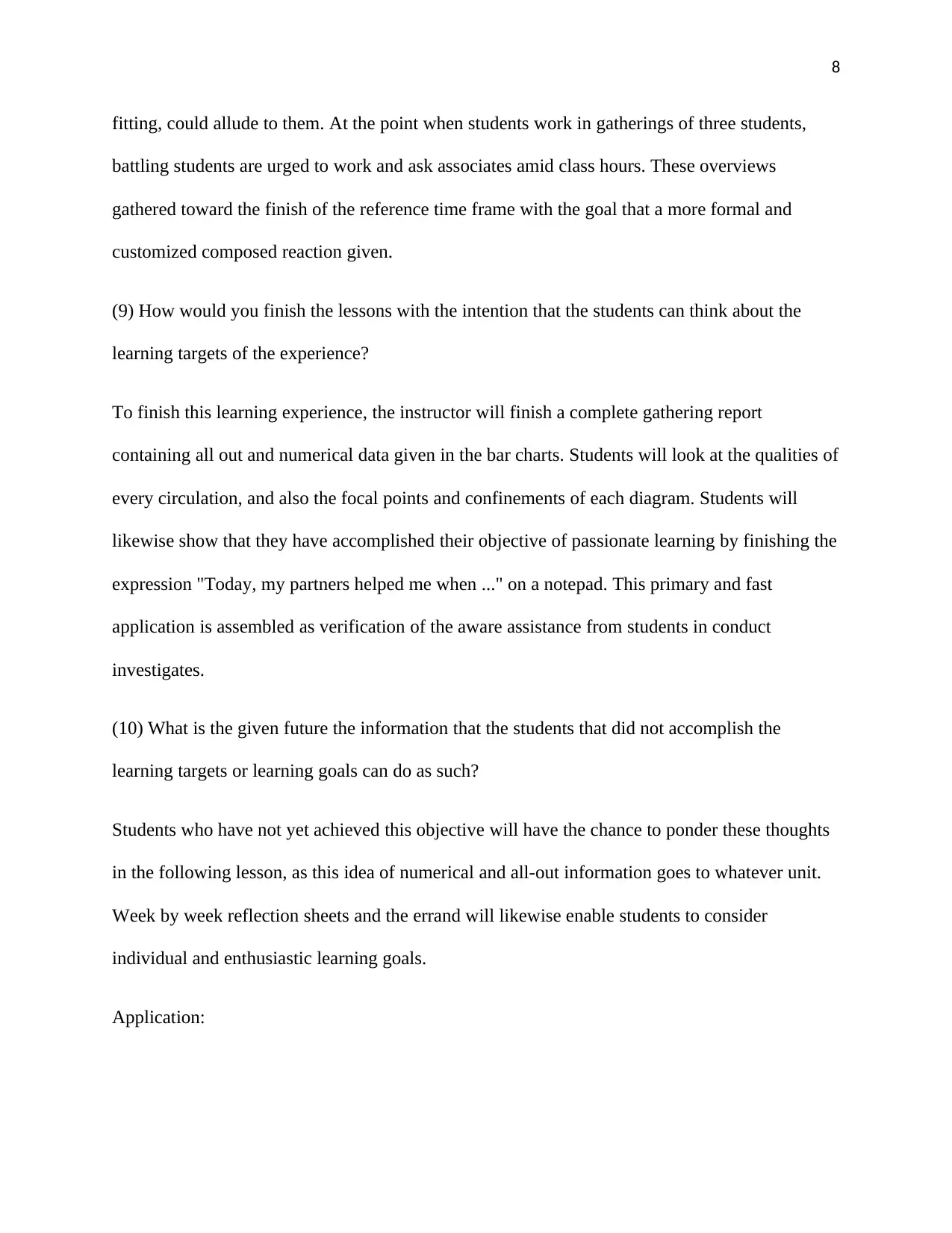
8
fitting, could allude to them. At the point when students work in gatherings of three students,
battling students are urged to work and ask associates amid class hours. These overviews
gathered toward the finish of the reference time frame with the goal that a more formal and
customized composed reaction given.
(9) How would you finish the lessons with the intention that the students can think about the
learning targets of the experience?
To finish this learning experience, the instructor will finish a complete gathering report
containing all out and numerical data given in the bar charts. Students will look at the qualities of
every circulation, and also the focal points and confinements of each diagram. Students will
likewise show that they have accomplished their objective of passionate learning by finishing the
expression "Today, my partners helped me when ..." on a notepad. This primary and fast
application is assembled as verification of the aware assistance from students in conduct
investigates.
(10) What is the given future the information that the students that did not accomplish the
learning targets or learning goals can do as such?
Students who have not yet achieved this objective will have the chance to ponder these thoughts
in the following lesson, as this idea of numerical and all-out information goes to whatever unit.
Week by week reflection sheets and the errand will likewise enable students to consider
individual and enthusiastic learning goals.
Application:
fitting, could allude to them. At the point when students work in gatherings of three students,
battling students are urged to work and ask associates amid class hours. These overviews
gathered toward the finish of the reference time frame with the goal that a more formal and
customized composed reaction given.
(9) How would you finish the lessons with the intention that the students can think about the
learning targets of the experience?
To finish this learning experience, the instructor will finish a complete gathering report
containing all out and numerical data given in the bar charts. Students will look at the qualities of
every circulation, and also the focal points and confinements of each diagram. Students will
likewise show that they have accomplished their objective of passionate learning by finishing the
expression "Today, my partners helped me when ..." on a notepad. This primary and fast
application is assembled as verification of the aware assistance from students in conduct
investigates.
(10) What is the given future the information that the students that did not accomplish the
learning targets or learning goals can do as such?
Students who have not yet achieved this objective will have the chance to ponder these thoughts
in the following lesson, as this idea of numerical and all-out information goes to whatever unit.
Week by week reflection sheets and the errand will likewise enable students to consider
individual and enthusiastic learning goals.
Application:
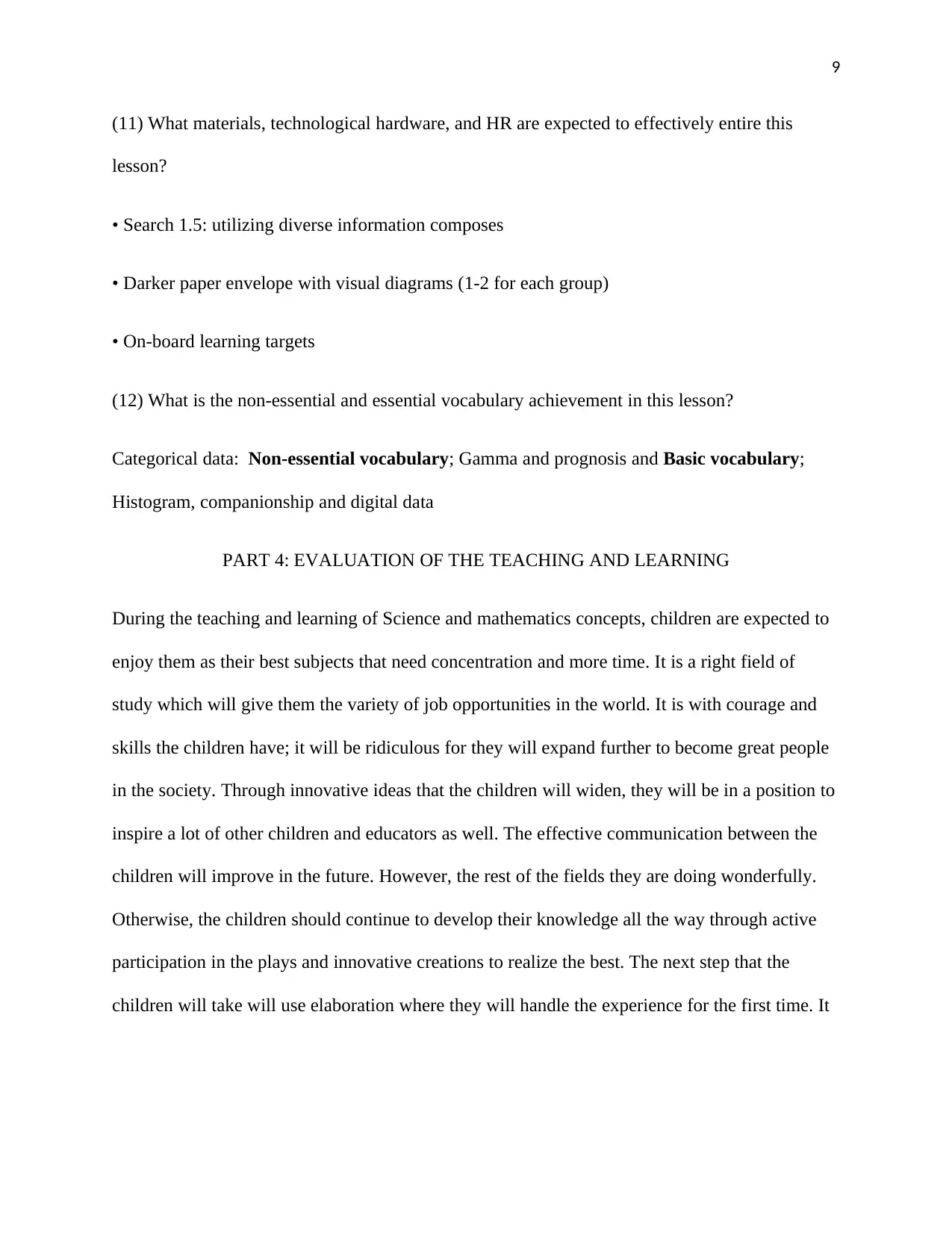
9
(11) What materials, technological hardware, and HR are expected to effectively entire this
lesson?
• Search 1.5: utilizing diverse information composes
• Darker paper envelope with visual diagrams (1-2 for each group)
• On-board learning targets
(12) What is the non-essential and essential vocabulary achievement in this lesson?
Categorical data: Non-essential vocabulary; Gamma and prognosis and Basic vocabulary;
Histogram, companionship and digital data
PART 4: EVALUATION OF THE TEACHING AND LEARNING
During the teaching and learning of Science and mathematics concepts, children are expected to
enjoy them as their best subjects that need concentration and more time. It is a right field of
study which will give them the variety of job opportunities in the world. It is with courage and
skills the children have; it will be ridiculous for they will expand further to become great people
in the society. Through innovative ideas that the children will widen, they will be in a position to
inspire a lot of other children and educators as well. The effective communication between the
children will improve in the future. However, the rest of the fields they are doing wonderfully.
Otherwise, the children should continue to develop their knowledge all the way through active
participation in the plays and innovative creations to realize the best. The next step that the
children will take will use elaboration where they will handle the experience for the first time. It
(11) What materials, technological hardware, and HR are expected to effectively entire this
lesson?
• Search 1.5: utilizing diverse information composes
• Darker paper envelope with visual diagrams (1-2 for each group)
• On-board learning targets
(12) What is the non-essential and essential vocabulary achievement in this lesson?
Categorical data: Non-essential vocabulary; Gamma and prognosis and Basic vocabulary;
Histogram, companionship and digital data
PART 4: EVALUATION OF THE TEACHING AND LEARNING
During the teaching and learning of Science and mathematics concepts, children are expected to
enjoy them as their best subjects that need concentration and more time. It is a right field of
study which will give them the variety of job opportunities in the world. It is with courage and
skills the children have; it will be ridiculous for they will expand further to become great people
in the society. Through innovative ideas that the children will widen, they will be in a position to
inspire a lot of other children and educators as well. The effective communication between the
children will improve in the future. However, the rest of the fields they are doing wonderfully.
Otherwise, the children should continue to develop their knowledge all the way through active
participation in the plays and innovative creations to realize the best. The next step that the
children will take will use elaboration where they will handle the experience for the first time. It
Secure Best Marks with AI Grader
Need help grading? Try our AI Grader for instant feedback on your assignments.
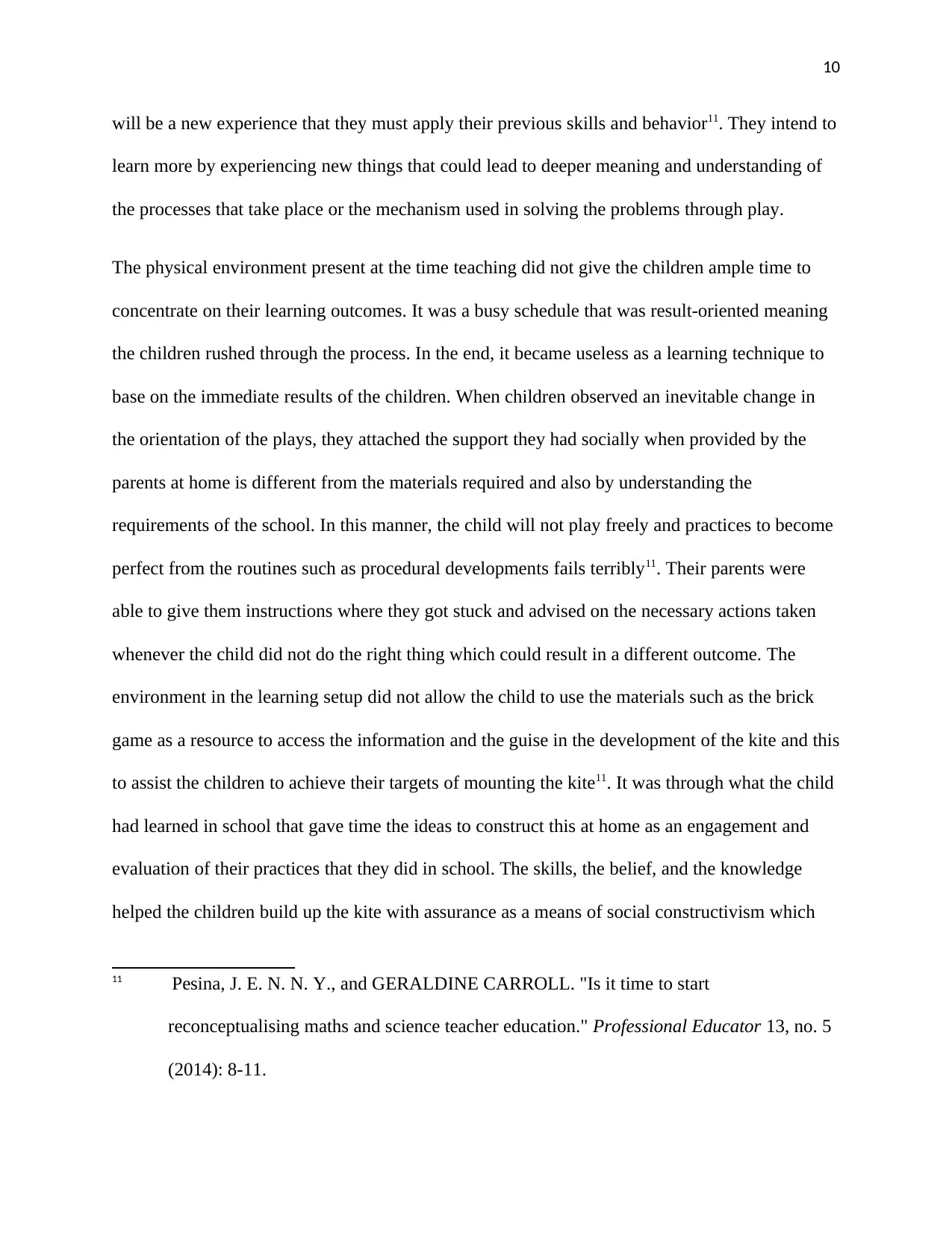
10
will be a new experience that they must apply their previous skills and behavior11. They intend to
learn more by experiencing new things that could lead to deeper meaning and understanding of
the processes that take place or the mechanism used in solving the problems through play.
The physical environment present at the time teaching did not give the children ample time to
concentrate on their learning outcomes. It was a busy schedule that was result-oriented meaning
the children rushed through the process. In the end, it became useless as a learning technique to
base on the immediate results of the children. When children observed an inevitable change in
the orientation of the plays, they attached the support they had socially when provided by the
parents at home is different from the materials required and also by understanding the
requirements of the school. In this manner, the child will not play freely and practices to become
perfect from the routines such as procedural developments fails terribly11. Their parents were
able to give them instructions where they got stuck and advised on the necessary actions taken
whenever the child did not do the right thing which could result in a different outcome. The
environment in the learning setup did not allow the child to use the materials such as the brick
game as a resource to access the information and the guise in the development of the kite and this
to assist the children to achieve their targets of mounting the kite11. It was through what the child
had learned in school that gave time the ideas to construct this at home as an engagement and
evaluation of their practices that they did in school. The skills, the belief, and the knowledge
helped the children build up the kite with assurance as a means of social constructivism which
11 Pesina, J. E. N. N. Y., and GERALDINE CARROLL. "Is it time to start
reconceptualising maths and science teacher education." Professional Educator 13, no. 5
(2014): 8-11.
will be a new experience that they must apply their previous skills and behavior11. They intend to
learn more by experiencing new things that could lead to deeper meaning and understanding of
the processes that take place or the mechanism used in solving the problems through play.
The physical environment present at the time teaching did not give the children ample time to
concentrate on their learning outcomes. It was a busy schedule that was result-oriented meaning
the children rushed through the process. In the end, it became useless as a learning technique to
base on the immediate results of the children. When children observed an inevitable change in
the orientation of the plays, they attached the support they had socially when provided by the
parents at home is different from the materials required and also by understanding the
requirements of the school. In this manner, the child will not play freely and practices to become
perfect from the routines such as procedural developments fails terribly11. Their parents were
able to give them instructions where they got stuck and advised on the necessary actions taken
whenever the child did not do the right thing which could result in a different outcome. The
environment in the learning setup did not allow the child to use the materials such as the brick
game as a resource to access the information and the guise in the development of the kite and this
to assist the children to achieve their targets of mounting the kite11. It was through what the child
had learned in school that gave time the ideas to construct this at home as an engagement and
evaluation of their practices that they did in school. The skills, the belief, and the knowledge
helped the children build up the kite with assurance as a means of social constructivism which
11 Pesina, J. E. N. N. Y., and GERALDINE CARROLL. "Is it time to start
reconceptualising maths and science teacher education." Professional Educator 13, no. 5
(2014): 8-11.
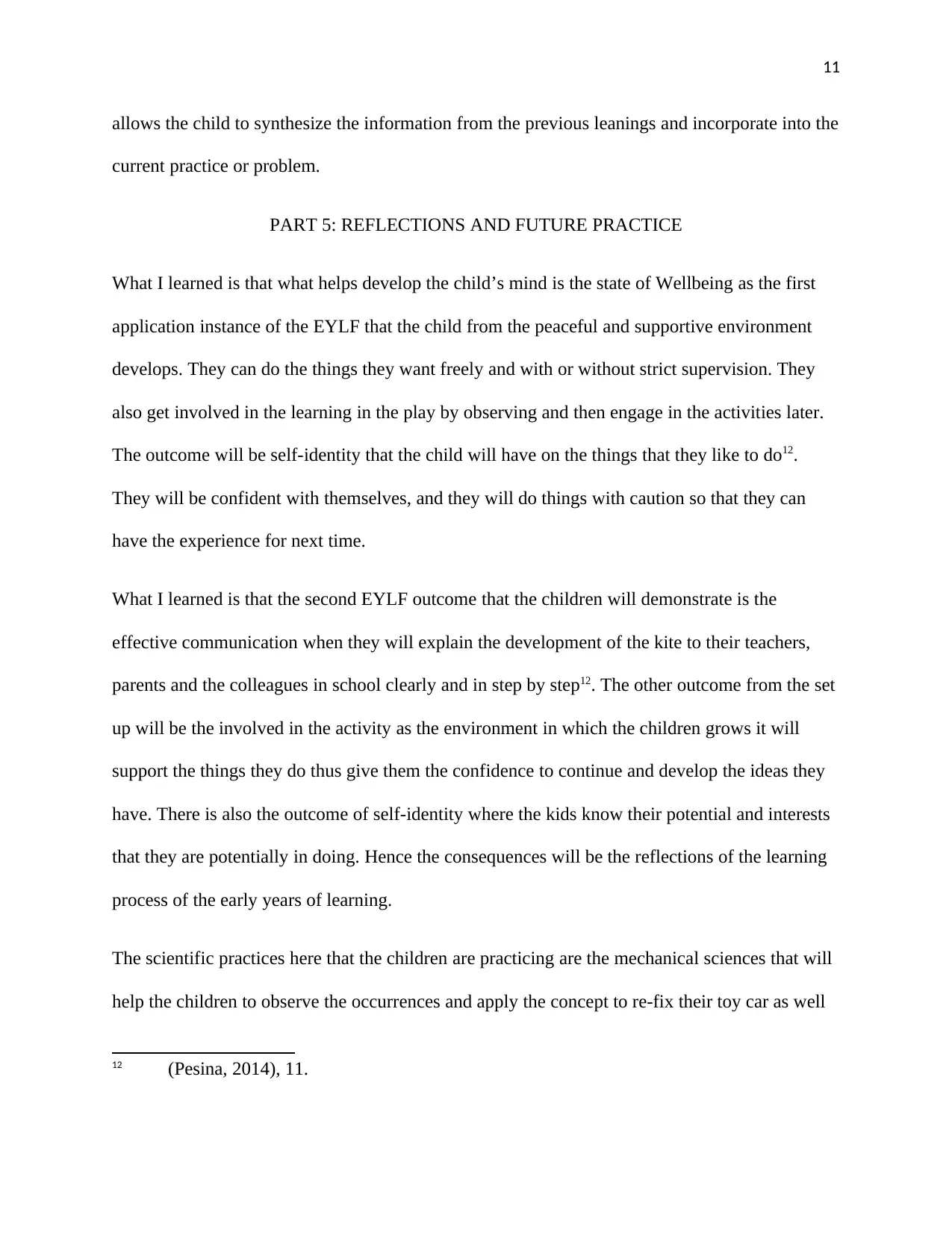
11
allows the child to synthesize the information from the previous leanings and incorporate into the
current practice or problem.
PART 5: REFLECTIONS AND FUTURE PRACTICE
What I learned is that what helps develop the child’s mind is the state of Wellbeing as the first
application instance of the EYLF that the child from the peaceful and supportive environment
develops. They can do the things they want freely and with or without strict supervision. They
also get involved in the learning in the play by observing and then engage in the activities later.
The outcome will be self-identity that the child will have on the things that they like to do12.
They will be confident with themselves, and they will do things with caution so that they can
have the experience for next time.
What I learned is that the second EYLF outcome that the children will demonstrate is the
effective communication when they will explain the development of the kite to their teachers,
parents and the colleagues in school clearly and in step by step12. The other outcome from the set
up will be the involved in the activity as the environment in which the children grows it will
support the things they do thus give them the confidence to continue and develop the ideas they
have. There is also the outcome of self-identity where the kids know their potential and interests
that they are potentially in doing. Hence the consequences will be the reflections of the learning
process of the early years of learning.
The scientific practices here that the children are practicing are the mechanical sciences that will
help the children to observe the occurrences and apply the concept to re-fix their toy car as well
12 (Pesina, 2014), 11.
allows the child to synthesize the information from the previous leanings and incorporate into the
current practice or problem.
PART 5: REFLECTIONS AND FUTURE PRACTICE
What I learned is that what helps develop the child’s mind is the state of Wellbeing as the first
application instance of the EYLF that the child from the peaceful and supportive environment
develops. They can do the things they want freely and with or without strict supervision. They
also get involved in the learning in the play by observing and then engage in the activities later.
The outcome will be self-identity that the child will have on the things that they like to do12.
They will be confident with themselves, and they will do things with caution so that they can
have the experience for next time.
What I learned is that the second EYLF outcome that the children will demonstrate is the
effective communication when they will explain the development of the kite to their teachers,
parents and the colleagues in school clearly and in step by step12. The other outcome from the set
up will be the involved in the activity as the environment in which the children grows it will
support the things they do thus give them the confidence to continue and develop the ideas they
have. There is also the outcome of self-identity where the kids know their potential and interests
that they are potentially in doing. Hence the consequences will be the reflections of the learning
process of the early years of learning.
The scientific practices here that the children are practicing are the mechanical sciences that will
help the children to observe the occurrences and apply the concept to re-fix their toy car as well
12 (Pesina, 2014), 11.
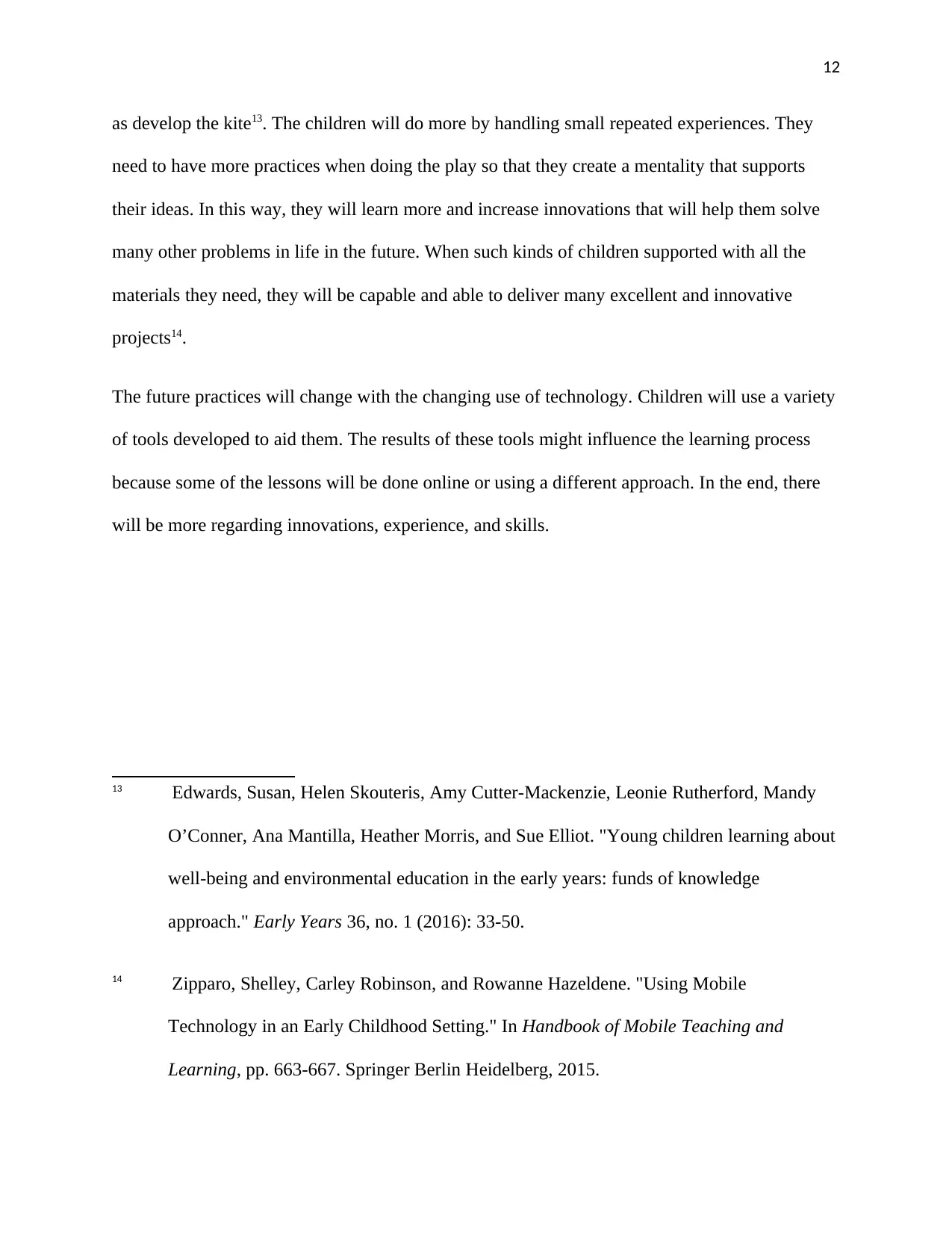
12
as develop the kite13. The children will do more by handling small repeated experiences. They
need to have more practices when doing the play so that they create a mentality that supports
their ideas. In this way, they will learn more and increase innovations that will help them solve
many other problems in life in the future. When such kinds of children supported with all the
materials they need, they will be capable and able to deliver many excellent and innovative
projects14.
The future practices will change with the changing use of technology. Children will use a variety
of tools developed to aid them. The results of these tools might influence the learning process
because some of the lessons will be done online or using a different approach. In the end, there
will be more regarding innovations, experience, and skills.
13 Edwards, Susan, Helen Skouteris, Amy Cutter-Mackenzie, Leonie Rutherford, Mandy
O’Conner, Ana Mantilla, Heather Morris, and Sue Elliot. "Young children learning about
well-being and environmental education in the early years: funds of knowledge
approach." Early Years 36, no. 1 (2016): 33-50.
14 Zipparo, Shelley, Carley Robinson, and Rowanne Hazeldene. "Using Mobile
Technology in an Early Childhood Setting." In Handbook of Mobile Teaching and
Learning, pp. 663-667. Springer Berlin Heidelberg, 2015.
as develop the kite13. The children will do more by handling small repeated experiences. They
need to have more practices when doing the play so that they create a mentality that supports
their ideas. In this way, they will learn more and increase innovations that will help them solve
many other problems in life in the future. When such kinds of children supported with all the
materials they need, they will be capable and able to deliver many excellent and innovative
projects14.
The future practices will change with the changing use of technology. Children will use a variety
of tools developed to aid them. The results of these tools might influence the learning process
because some of the lessons will be done online or using a different approach. In the end, there
will be more regarding innovations, experience, and skills.
13 Edwards, Susan, Helen Skouteris, Amy Cutter-Mackenzie, Leonie Rutherford, Mandy
O’Conner, Ana Mantilla, Heather Morris, and Sue Elliot. "Young children learning about
well-being and environmental education in the early years: funds of knowledge
approach." Early Years 36, no. 1 (2016): 33-50.
14 Zipparo, Shelley, Carley Robinson, and Rowanne Hazeldene. "Using Mobile
Technology in an Early Childhood Setting." In Handbook of Mobile Teaching and
Learning, pp. 663-667. Springer Berlin Heidelberg, 2015.
Paraphrase This Document
Need a fresh take? Get an instant paraphrase of this document with our AI Paraphraser

13
Bibliography
Ali, Suraini Mohd, Haliza Harun, Norhaili Massari, Fariza Puteh-Behak, Ramiaida Darmi,
Normazla Ahmad Mahir, Suzana Selamat, and Yurni Emilia Abd Hamid. "The 21st
century skills in online multiliteracies project approach (eMULPA): Learners’ reflections
on their knowledge processes." Mediterranean Journal of Social Sciences 8, no. 1 (2017):
252.
Brechan, Bjorn, Sigbjorn Sangesland, Stein Inge Dale, and Brendan Aranjo. "Interactive
Experience and Learning Model can Reduce Non-Productive Time NPT." In Offshore
Technology Conference Asia. Offshore Technology Conference, 2018.
Campbell, Coral. "Early childhood science exploration: A vehicle for inclusive practices." New
Zealand Research in Early Childhood Education 19 (2016): 1.
Cherrington, Sue. "Early childhood teachers’ thinking and reflection: a model of current practice
in New Zealand." Early Years 38, no. 3 (2018): 316-332.
Cohrssen, Caroline, and Jane Page. "Articulating a rights-based argument for mathematics
teaching and learning in early childhood education." Australasian Journal of Early
Childhood 41, no. 3 (2016): 104.
Cohrssen, Caroline, Collette Tayler, and Dan Cloney. "Playing with maths: Implications for
early childhood mathematics teaching from an implementation study in Melbourne,
Australia." Education 3-13 43, no. 6 (2015): 641-652.
Edwards, Susan, Helen Skouteris, Amy Cutter-Mackenzie, Leonie Rutherford, Mandy
O’Conner, Ana Mantilla, Heather Morris, and Sue Elliot. "Young children learning about
well-being and environmental education in the early years: funds of knowledge
approach." Early Years 36, no. 1 (2016): 33-50.
Bibliography
Ali, Suraini Mohd, Haliza Harun, Norhaili Massari, Fariza Puteh-Behak, Ramiaida Darmi,
Normazla Ahmad Mahir, Suzana Selamat, and Yurni Emilia Abd Hamid. "The 21st
century skills in online multiliteracies project approach (eMULPA): Learners’ reflections
on their knowledge processes." Mediterranean Journal of Social Sciences 8, no. 1 (2017):
252.
Brechan, Bjorn, Sigbjorn Sangesland, Stein Inge Dale, and Brendan Aranjo. "Interactive
Experience and Learning Model can Reduce Non-Productive Time NPT." In Offshore
Technology Conference Asia. Offshore Technology Conference, 2018.
Campbell, Coral. "Early childhood science exploration: A vehicle for inclusive practices." New
Zealand Research in Early Childhood Education 19 (2016): 1.
Cherrington, Sue. "Early childhood teachers’ thinking and reflection: a model of current practice
in New Zealand." Early Years 38, no. 3 (2018): 316-332.
Cohrssen, Caroline, and Jane Page. "Articulating a rights-based argument for mathematics
teaching and learning in early childhood education." Australasian Journal of Early
Childhood 41, no. 3 (2016): 104.
Cohrssen, Caroline, Collette Tayler, and Dan Cloney. "Playing with maths: Implications for
early childhood mathematics teaching from an implementation study in Melbourne,
Australia." Education 3-13 43, no. 6 (2015): 641-652.
Edwards, Susan, Helen Skouteris, Amy Cutter-Mackenzie, Leonie Rutherford, Mandy
O’Conner, Ana Mantilla, Heather Morris, and Sue Elliot. "Young children learning about
well-being and environmental education in the early years: funds of knowledge
approach." Early Years 36, no. 1 (2016): 33-50.
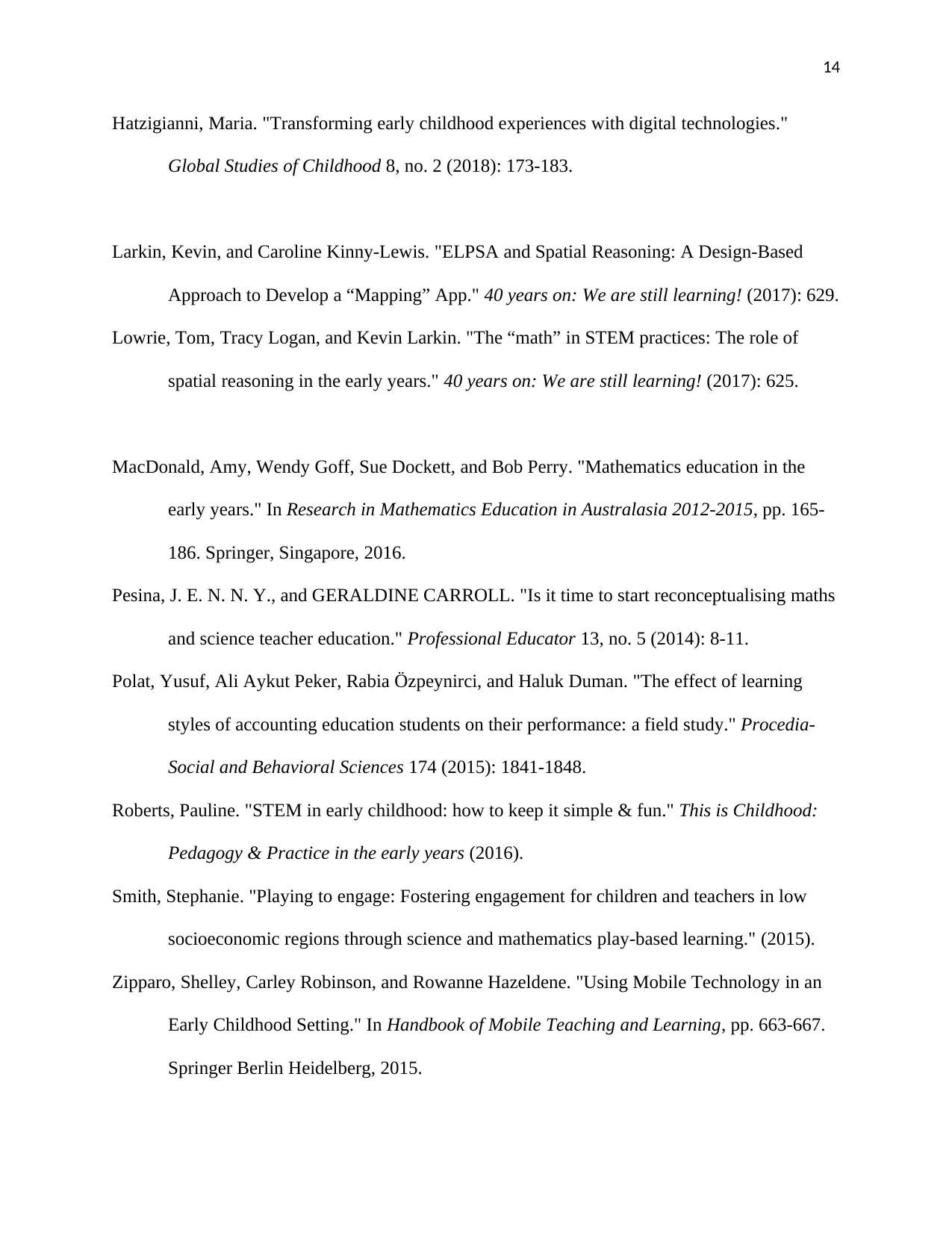
14
Hatzigianni, Maria. "Transforming early childhood experiences with digital technologies."
Global Studies of Childhood 8, no. 2 (2018): 173-183.
Larkin, Kevin, and Caroline Kinny-Lewis. "ELPSA and Spatial Reasoning: A Design-Based
Approach to Develop a “Mapping” App." 40 years on: We are still learning! (2017): 629.
Lowrie, Tom, Tracy Logan, and Kevin Larkin. "The “math” in STEM practices: The role of
spatial reasoning in the early years." 40 years on: We are still learning! (2017): 625.
MacDonald, Amy, Wendy Goff, Sue Dockett, and Bob Perry. "Mathematics education in the
early years." In Research in Mathematics Education in Australasia 2012-2015, pp. 165-
186. Springer, Singapore, 2016.
Pesina, J. E. N. N. Y., and GERALDINE CARROLL. "Is it time to start reconceptualising maths
and science teacher education." Professional Educator 13, no. 5 (2014): 8-11.
Polat, Yusuf, Ali Aykut Peker, Rabia Özpeynirci, and Haluk Duman. "The effect of learning
styles of accounting education students on their performance: a field study." Procedia-
Social and Behavioral Sciences 174 (2015): 1841-1848.
Roberts, Pauline. "STEM in early childhood: how to keep it simple & fun." This is Childhood:
Pedagogy & Practice in the early years (2016).
Smith, Stephanie. "Playing to engage: Fostering engagement for children and teachers in low
socioeconomic regions through science and mathematics play-based learning." (2015).
Zipparo, Shelley, Carley Robinson, and Rowanne Hazeldene. "Using Mobile Technology in an
Early Childhood Setting." In Handbook of Mobile Teaching and Learning, pp. 663-667.
Springer Berlin Heidelberg, 2015.
Hatzigianni, Maria. "Transforming early childhood experiences with digital technologies."
Global Studies of Childhood 8, no. 2 (2018): 173-183.
Larkin, Kevin, and Caroline Kinny-Lewis. "ELPSA and Spatial Reasoning: A Design-Based
Approach to Develop a “Mapping” App." 40 years on: We are still learning! (2017): 629.
Lowrie, Tom, Tracy Logan, and Kevin Larkin. "The “math” in STEM practices: The role of
spatial reasoning in the early years." 40 years on: We are still learning! (2017): 625.
MacDonald, Amy, Wendy Goff, Sue Dockett, and Bob Perry. "Mathematics education in the
early years." In Research in Mathematics Education in Australasia 2012-2015, pp. 165-
186. Springer, Singapore, 2016.
Pesina, J. E. N. N. Y., and GERALDINE CARROLL. "Is it time to start reconceptualising maths
and science teacher education." Professional Educator 13, no. 5 (2014): 8-11.
Polat, Yusuf, Ali Aykut Peker, Rabia Özpeynirci, and Haluk Duman. "The effect of learning
styles of accounting education students on their performance: a field study." Procedia-
Social and Behavioral Sciences 174 (2015): 1841-1848.
Roberts, Pauline. "STEM in early childhood: how to keep it simple & fun." This is Childhood:
Pedagogy & Practice in the early years (2016).
Smith, Stephanie. "Playing to engage: Fostering engagement for children and teachers in low
socioeconomic regions through science and mathematics play-based learning." (2015).
Zipparo, Shelley, Carley Robinson, and Rowanne Hazeldene. "Using Mobile Technology in an
Early Childhood Setting." In Handbook of Mobile Teaching and Learning, pp. 663-667.
Springer Berlin Heidelberg, 2015.
1 out of 15
Your All-in-One AI-Powered Toolkit for Academic Success.
+13062052269
info@desklib.com
Available 24*7 on WhatsApp / Email
![[object Object]](/_next/static/media/star-bottom.7253800d.svg)
Unlock your academic potential
© 2024 | Zucol Services PVT LTD | All rights reserved.



